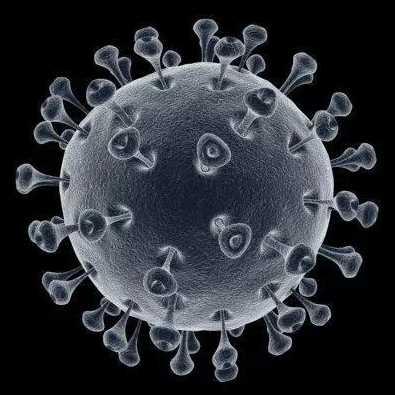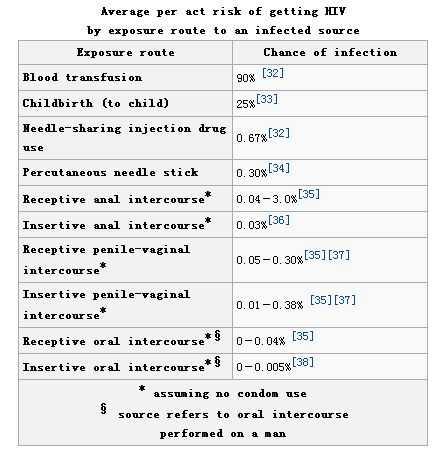How contagious is AIDS, and will a person's immune system stop the virus from invading in the first place?
Thanks to the subject for the invitation.
probability of transmission
Let me answer the question carefully. The main ways of HIV transmission are: sex, mother-to-child, and blood. Let me give you a detailed explanation of the three ways.
Let's start by analyzing the core issue of these modes of transmission which is, body fluid exchange and blood exchange. The first thing you need to know is that the virus in HIV carriers is found primarily in blood and body fluids. Body fluid transmission requires a viral concentration of 500 ml, that is, to you to flush a mineral water bottle of body fluids in order to be infected, of course, if you do not have a wound to flush a tank of oil is also useless. And blood exchange virus concentration is relatively high, some organizations say it is 1ml also some organizations say it is 5ml. 20 drops of blood is 1ml, you can imagine yourself. But all the ways of transmission is a focus called exchange, there is a wound called exchange, sexual intercourse is also called exchange. So if you don't have a wound and blood drips on your skin, it's not called exchange.
Let's talk about the chance of transmission, the highest chance of transmission among the 3 routes is blood, and of course this blood transmission is blood transfusion, which has a 98% chance of infection, but of course I don't mean that blood transfusion is contagious. First, the blood exchange after your transfusion is at least several hundred milliliters. Second, if the blood is HIV infected blood is infected. Fortunately, if you go to a tertiary care hospital to get a transfusion of authentic blood products, this is not a concern at all. Because blood stations are now quite strict in detecting blood infections, this point can be completely ignored as long as you don't use blood products of unknown origin.
The second highest chance is mother-to-child, which can be reduced to 30% or less with modern medical technology interventions.
The third highest rate is sexual transmission, which, although low, is the most widespread form of HIV transmission. I have a set of data for you to look at. The first data all belong to high-risk sexual behavior, that is, no condom, sexual intercourse passive party, that is, male to female, a chance of 0.1%-0.2%. And the active side, that is, the female to male once the chance is 0.033%-0.1%. In terms of exchange of bodily fluids it is the female who is passive. Of course there is a special example here, male to male transmission is 0.5%-3.0%. Male-to-male behavior is more specific because he involves exchange of bodily fluids and exchange of blood. Of course if you're having safe sex, which is using a condom, all of this is a no-brainer.
On the immune system stopping HIV
The human immune system is very strong and can stop many viruses as well as bacteria. But I am sorry to tell you that the immune system has no effect on HIV. Because HIV is a lymphocyte-phagic virus, his prey is immune T cells and macrophages. You may not understand the cytology of this, but just know that it is these cells that he relies on to reproduce. The immune system is proactive, but in the case of HIV, it is proactive in "giving away the head". If HIV is unfortunate enough to enter your wound and there are no immune cells in the wound, then the virus may give up, but if there are immune cells, they will be the first meal to enter your body. That's not to say that one virus coming in is the end of the story either, if the virus that enters your body isn't concentrated enough, it's also going to be abused by the immune cells. So it all has to be based on a sufficient amount of virus concentration, see above for specific concentrations.
When a sufficient amount of virus into the human body, certainly the first with the immune system "war", this time the symptoms of the acute phase of AIDS, in fact, the immune cells no matter with whom the human body will appear this symptom of war, which is why the AIDS does not look at the symptom, because you have a cold is also the symptom. Needless to say, the immune cells absolutely can not beat HIV, you may ask, just a few viruses are so powerful? I'm sorry to tell you that HIV relies on these immune cells to reproduce, HIV injects its RNA into the immune cells, and after completing the reverse transcription, the immune cells break down and come out all HIV. This battle until your body's immune cells are not enough, the immune system will produce a large number of immune cells, but the more they produce the more converted HIV, so that the immune system has been broken down, is the onset of HIV. How's that for a better understanding?
Despite all this talk, it feels like it's scary, but the virus itself is characterized by vulnerability, and HIV leaves the dry environment of the body and basically hangs up instantly. So there is not so terrible, as long as you do clean, have a fixed sexual partner, no homosexual behavior, the back of all the terrible things said have nothing to do with you. As for the rumors of what injected, needles, what, after reading the smile on the line, spread rumors is illegal Oh.
The above purely hand-typed, I hope it can help the subject, away from AIDS, away from the fear of AIDS. Start with yourself.
Thanks for the invite.
This question is divided into two sub-questions, the first of which is:
probability (math.)
I have an article dedicated to this issue of the chances of HIV transmission. There are three ways of HIV transmission" is now common knowledge among elementary school children, namely: blood transmission, sexual transmission, and mother-to-child transmission (80% of infections occur through sexual transmission).
Regardless of the route, there are three conditions for transmission:
1. HIV-infected persons
2. Sufficient amount of virus is excreted from the infected person
3. HIV must enter the circulatory system of the infected person

It would seem that the higher the level of the virus in a patient, the greater the risk of transmitting it to others by any means, and sexual transmission is no exception. Naturally, if viral replication can be suppressed, thereby reducing the level of virus in the patient, then the infectivity of the HIV-infected person will be greatly reduced.

If a normal person is transfused with the blood of an HIV-positive person or an AIDS patient, the chance of infection is 95%, and the chance of infection of a HIV-positive person or a patient who has already developed the disease and a normal person who has unprotected sex "on a single occasion" has a certain relationship with the gender, and the chance of male to female is 0.38%, female to male is 0.3%, and male to male is much larger than the above two ways about 0.04% to 3%. The chance of male-to-female transmission is 0.38%, the chance of female-to-male transmission is 0.3%, and the chance of male-to-male transmission is much greater than the above two ways, about 0.04% to 3%. If the mother is HIV-positive or has AIDS, the chance of her fetus being infected is 25%, but if the mother is treated with antiretroviral therapy (AZT), the chance of her fetus being infected is reduced to 8%; and if she is treated with combination therapy (cocktail), the chance of her fetus being infected may be reduced to 2%. HIV is a very fragile virus that is sensitive to heat and dryness. HIV dies in 10 minutes in a dry environment and is inactivated in 30 minutes at 60 degrees Celsius. If a syringe with blood that has just touched a patient's body is immediately inserted into a normal person, the chance of infection is less than 0.3%.
The second question is, will the body's immune system stop the HIV virus from invading?
This is of course, the exclusion of self, but unfortunately, the immune system has no effect on HIV, because HIV is a lymphocyte-phagocytosis virus, he can be immune T cells and macrophages through the reverse transcription to kill, HIV is to rely on these immune cells to reproduce, HIV injected its own RNA into the body of the immune cells, the completion of the reversal of transcription of the immune cells out of the collapse of the HIV virus. After the reverse transcription is completed, the immune cells break down and all that comes out is HIV. In this way, your body's immune system will produce a large number of immune cells, but the more it produces, the more it converts into HIV, and if the HIV virus is not controlled, the body's immune system will break down, and that's the onset of the onset of HIV.
In this way, some behaviors are not considered high probability, but there is no other number in between 0% and 100%, and as HIV itself cannot be completely solved at the current level of science, we should all maintain due vigilance and safety measures to protect ourselves as well as be responsible for others while not discriminating against or fearing AIDS.
Why do people fear the night - because there is no light and you can't see anything.
AIDS isn't really scary - it's ignorance and rumors that are scary.
The infection rate of AIDS is not high, China's AIDS infection rate is at zero percent, not high. Sichuan, Yunnan and Guangxi account for about 45% of all infected people in the country.
There are only three ways of HIV infection, that is, sex, mother-to-child, and blood, in which sexual behavior, if no protective measures are taken, the probability of male to female transmission is about 0.6%, female to male is about 0.056%, and male to male is as high as about 75%, and if protective measures are taken, then the infection rate will drop dramatically, and it can be reduced at least by more than 98%.
The human immune system will be the first time to stop the invasion of the virus, for example, at the beginning of the infection of this virus, the body will appear fever, dizziness, headache, lymph nodes a transient swelling, these symptoms are similar to our symptoms of the flu, so usually it is easy to ignore.
There is no definition of how high the rate of transmission is, this is case by case.
Let me explain in general terms, in language that is understandable to the people, that HIV is mainly transmitted through the bloodstream.
Blood with HIV on normal, unbroken skin is not infectious.
Can sexual intercourse be infected. Mucous membrane damage during sexual intercourse (which is difficult to avoid) can lead to infection. So, please remember to wear TT.
Breathing, droplets do not transmit AIDS.
Mosquito bites are not transmitted. Not transmitted by daily contact.
Infection with HIV is indeed terrible, but the mode of transmission is limited, then even if infected, there are now a variety of drugs that can inhibit HIV replication. And it can be controlled for life.
So there is no need for people to panic blindly.
Don't be misled! What percent of the goddamned male to male transmission, what percent of the male to female transmission, this is probability statistics, not inaccurate, but quite problematic. For example, the chance is one in a thousand, not that you engage in a thousand times out of a time, this is the average, and you average of those people and your health situation genetically different, who knows which is easy to get the disease, for you, it may be every time a hundred percent, even if the person is the same person, one in a thousand is a thousand times there is a time, but this is a fatal time when to, not by yourself to do the job, may be the first time on the contraction, the most correct! is to stay away from temptation and reject the danger.
In general, if the person's physique is relatively good, not easily infected, such as skin break a small mouth, and after contact with AIDS people, that the chances of infection is particularly high, no matter where the skin breaks the mouth, and AIDS people contact, the chances of infection is particularly high, blood transmission, mother-to-child transmission, and sexually transmitted, the specific to go to the examination, the person's immune system is relatively high in the case of the general is not easily infected by you, but the security You should also pay attention to the safety aspect.
No matter how high, not infected is 0%, infected is 100%, don't take a chance, do a good job of protection, but it seems to count the chances are not really high, are percent, thousandths of a percent. The first two of these are the ones that are not as likely as the others, and they are the ones that are not as likely as the others, and they are the ones that are not as likely as the others, and they are the ones that are not as likely as the others!
The mention of AIDS inevitably makes people turn pale when they talk about it because it is a malignant infectious disease that is difficult to cure, has a high mortality rate, and has a bad reputation, which makes people suffer a lot. It has been reported that HIV is transmitted by chimpanzees, and the infection rate is high among young men, and has been on the rise in recent years. It is transmitted from mother to child, blood, sexual behavior, it has been proved that the human immune system has no effect on HIV, because HIV is a kind of phagocytic virus, the country attaches great importance to effective drugs, vaccines continue to innovate I believe that soon there will be a way to cure, prevention. Prevention is very important, we hope that the people, to be clean, strict premarital examination, strict blood products, hygiene to cut off the source of infection.

HIV infection rate is very low, very low, the virus leaves the pathogen will die in a few seconds, but as long as the human immune system is infected can not be stopped, as long as the epidemic prevention is the main, so I urge you to pay attention to hygiene and cleanliness!

The rate of HIV transmission through sex and blood is still very high, the human immune system will certainly be the first to stop the invasion of the virus, but between the enemy and us who lose and who win depends on luck, the best way is to go to the hospital to check.
This question and answer are from the site users, does not represent the position of the site, such as infringement, please contact the administrator to delete.